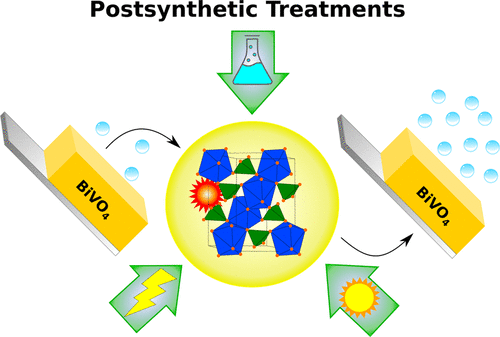当前位置:
X-MOL 学术
›
ACS Energy Lett.
›
论文详情
Our official English website, www.x-mol.net, welcomes your
feedback! (Note: you will need to create a separate account there.)
Emerging Postsynthetic Improvements of BiVO4 Photoanodes for Solar Water Splitting
ACS Energy Letters ( IF 19.3 ) Pub Date : 2017-11-22 00:00:00 , DOI: 10.1021/acsenergylett.7b00834 Benjamin Lamm 1 , Bartek J. Trześniewski 2 , Henning Döscher 3 , Wilson A. Smith 2 , Morgan Stefik 1
ACS Energy Letters ( IF 19.3 ) Pub Date : 2017-11-22 00:00:00 , DOI: 10.1021/acsenergylett.7b00834 Benjamin Lamm 1 , Bartek J. Trześniewski 2 , Henning Döscher 3 , Wilson A. Smith 2 , Morgan Stefik 1
Affiliation

|
Solar-assisted water splitting with bismuth vanadate (BiVO4) photoanodes has progressed significantly with many efforts devoted to improving charge separation and surface charge injection through synthetic methods, including dopants and catalytic layers. In contrast, postsynthetic treatments occur after the synthesis of electrodes. Recently, such postsynthetic treatments based upon illumination, chemistry, electrochemistry, or combinations thereof have led to dramatic improvements in the performance and efficiency of BiVO4 photoanodes. This Perspective summarizes recent BiVO4 postsynthetic treatments with mechanistic details and highlights important future directions. One broad challenge is that multiple interpretations of defect changes may be consistent with routine X-ray photoelectron spectroscopy data. Further experiments are suggested to better differentiate between the proposed defect changes. Also, performance changes are considered separately with respect to charge separation and charge injection efficiencies as well as within the context of known synthetic modifications. The emergence of postsynthetic treatments highlights new opportunities to understand and improve photoelectrodes. Similar mechanisms may be of further utility as researchers turn more focus toward the development of novel multinary metal oxide photoabsorbers for the production of solar fuels. Lastly, postsynthetic treatments also elucidate possible electrode changes under extended service and can provide new strategies to enable extended device performance.
中文翻译:

用于太阳能水分解的BiVO 4光阳极的新兴合成后改进
用钒酸铋(BiVO 4)光电阳极进行的太阳能辅助水分解已经取得了显着进展,其中许多努力致力于通过合成方法(包括掺杂剂和催化层)改善电荷分离和表面电荷注入。相反,在电极合成之后进行后合成处理。近来,基于照明,化学,电化学或其组合的这种合成后处理导致BiVO 4光阳极的性能和效率的显着改善。该观点总结了最近的BiVO 4具有机械细节的后合成处理,并突出了重要的未来方向。一个广泛的挑战是缺陷变化的多种解释可能与常规X射线光电子能谱数据一致。建议进行进一步的实验,以更好地区分建议的缺陷更改。同样,在电荷分离和电荷注入效率方面以及在已知的合成修饰的范围内,性能变化被认为是分开的。合成后处理的出现突出了理解和改善光电极的新机会。随着研究人员将更多的注意力转向用于生产太阳能燃料的新型多元金属氧化物光吸收剂的开发,类似的机制可能会进一步有用。最后,
更新日期:2017-11-22
中文翻译:

用于太阳能水分解的BiVO 4光阳极的新兴合成后改进
用钒酸铋(BiVO 4)光电阳极进行的太阳能辅助水分解已经取得了显着进展,其中许多努力致力于通过合成方法(包括掺杂剂和催化层)改善电荷分离和表面电荷注入。相反,在电极合成之后进行后合成处理。近来,基于照明,化学,电化学或其组合的这种合成后处理导致BiVO 4光阳极的性能和效率的显着改善。该观点总结了最近的BiVO 4具有机械细节的后合成处理,并突出了重要的未来方向。一个广泛的挑战是缺陷变化的多种解释可能与常规X射线光电子能谱数据一致。建议进行进一步的实验,以更好地区分建议的缺陷更改。同样,在电荷分离和电荷注入效率方面以及在已知的合成修饰的范围内,性能变化被认为是分开的。合成后处理的出现突出了理解和改善光电极的新机会。随着研究人员将更多的注意力转向用于生产太阳能燃料的新型多元金属氧化物光吸收剂的开发,类似的机制可能会进一步有用。最后,











































 京公网安备 11010802027423号
京公网安备 11010802027423号